Boeing Plant 1
Boeing Plant 1 (also known as Boeing Oxbow Plant) was the second Boeing airplane production facility which was the home of the Boeing Corporation between 1917 and 1965 in Seattle, Washington, USA. Boeing Plant 1 was responsible for the assembly and production of all aspects of the early Boeing airplane models produced until the completion of Boeing Plant 2 in 1936.
By the 1950s Boeing Plant 1 consisted of more than 20 buildings. The facility was made obsolete by the larger airplanes produced in the 1930s, and was used primarily as a forging plant and testing facility, as well as a producer of component parts used in the production of airplanes in other Boeing facilities. The Boeing Plant 1 site was sold to the Port of Seattle in 1970, and is currently located on the southern portion of the Port of Seattle Terminal 115 site.
Only two structures remain from the original Boeing Plant 1 site. One is Building No. 105, also known as the Red Barn, which is currently located at the Museum of Flight; the other is the 1929-vintage administration building, located on its original location, just south of the Terminal 115 site at 200 Southwest Michigan Street, Seattle.

History
In 1909, Edward Heath constructed a wooden boat shipyard on an oxbow meander of the Duwamish River. Heath soon became insolvent, and William Boeing, for whom Heath was building a hugely expensive and luxurious yacht, bought the shipyard and land for ten dollars, in exchange for Boeing's acceptance of Heath's debts.[1]
As war in Europe was looming for America, contracts for airplanes were being granted by the US Government. Boeing required a larger facility for the production of his airplanes, and with the completion of the Duwamish channelization project in 1916, the Heath Shipyard was an ideal location for the production of wooden seaplanes. The Boeing Company moved into the Heath Shipyard in 1917 and began producing aircraft from the simple barn-like structure, known as the Red Barn. The entirety of the aircraft was built within the barn's walls. During the first year of operations, Heath was the master woodsman in charge of woodworking at the factory until moving to Portland to start another wooden boat shipyard. Boeing expanded the facility through 1918, including a large assembly plant and several utility buildings.[2]
After World War I, the private air fleet experienced a glut of cheap surplus warplanes, and the demand for airplane production plummeted. The Boeing Company was forced to decimate its employed staff and began producing furniture in lieu of new airplane contracts. During this period, Boeing began designing and producing aircraft specialized in the air mail industry.[3]
In the mid to late 1920s demand for aircraft began to pick up as air travel and air mail began to increase in practicality and popularity. Additional expansion of the Boeing Plant 1 site was completed in 1925 and the early 1930s. The expansion included new machine shop facilities, a hammer drop facility, paint spraying and coating shops, and some component testing facilities.,.[4][5]

Prior to the completion of Boeing Plant 2, Boeing Plant 1 airplanes were produced and assembled onsite, taken apart, reassembled, taken apart again, barged to Boeing Airfield, flight tested, disassembled, and shipped to the buyer. This cumbersome process was simplified by the completion of Boeing Plant 2, which could also accommodate the larger airframes being produced in the 1930s. The last airplanes produced and assembled at the Boeing Plant 1 site were the Boeing 314 Clipper, and the XB-15, both seaplanes able to be assembled on the launching quay of the Plant 1 Assembly Building.
During World War II the Plant 1 site was responsible for the production of airplane components for warplanes and testing. The Boeing static test facilities were greatly expanded in 1942 for the testing of new aircraft.

In the post-war period Boeing Plant 1 was used primarily as a components production facility and a test facility for engines, components and fueling systems. These included fuel testing, a gun revetment, hydrostatic testing, static testing, and many others.[6]
The facility largely fell into decay in the 1960s, and the site was sold to the Port of Seattle as part of the larger Terminal 115 project.[7] The Boeing Plant 1 structures were demolished between the years 1970 and 1976. The now-famous red barn structure was nearly demolished, but was instead placed on the national historic register, barged down the river in 1975, and trucked to its current home at the Museum of Flight.[8]
References
- ↑ Spitzer, Paul. 1999. “Harsh Ways: Edward W Heath and the Shipbuilding Trade.” Pacific Northwest Quarterly Vol. 90 No 1.
- ↑ Puget Sound Regional Archives. Tax Rolls for King County Parcel No. 536720-2503 in Seattle, State of Washington.
- ↑ The Boeing Company Historical Archives. Year by year : 75 years of Boeing history, 1916-1991. The Boeing Company, 1991
- ↑ Puget Sound Regional Archives. Tax Rolls for King County Parcel No. 536720-2503.
- ↑ Sanborn Map Company, Inc., The 1950 Fire Insurance Maps of Seattle, Volume 3, Page 332. Reviewed at Seattle Public Library
- ↑ Puget Sound Regional Archives. Tax Rolls for King County Parcel No. 536720-2503 in Seattle, State of Washington.
- ↑ Carter, Glen. "Port Finds More Land". The Seattle Times, December 11, 1970, Section E.
- ↑ http://www.museumofflight.org/red-barn
Coordinates: 47°31′49.01″N 122°18′40.32″W / 47.5302806°N 122.3112000°W